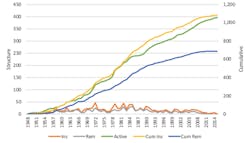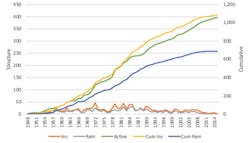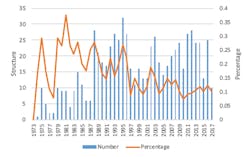Idle structures represent one-third of US GoM shallow-water inventory
Auxiliary platforms increasingly used for third-party production
Mark J Kaiser
Siddhartha Narra
Center for Energy Studies,
Louisiana State University
Idle structures are the least understood structures in the Gulf of Mexico (GoM) and auxiliary structures are the least appreciated. In the fifth part of this series on shallow-water GoM structures, idle structures are categorized using idle age, and the authors describe how well abandonment status can also be used to help characterize the inventory. It concludes with trends in auxiliary structures.
Circa 2017, there were 662 idle structures and 357 auxiliary structures in the GoM in water depth less than 400 ft (122 m), representing slightly more than half of the 1,905 current active structure inventory.
Idle structures
Idle structures are formerly producing structures that have not produced for at least one year. They may transition back into producing status if inactive wells are reactivated or side tracking is successful, or if all their inactive wells are permanently abandoned they may be re-purposed to serve another function in field development.
By definition, all idle structures previously produced hydrocarbons, but for some reason – the cause is not publicly reported – the structure was not producing for the previous 12 months. There are many reasons why production may stop, such as: uneconomic production, well failure, scheduled workovers, third-party problems (i.e., pipeline repair), recompletion, investment review, hurricane damage, fire, etc.
Production cessation may be short or long-term and since utility is not explicitly identified in BOEM databases, a subset of idle structures will be serving a useful function and idle structure counts will over estimate inventory size.
Operators strive to maintain their structure fleet for as long as possible to maximize the value of their investments, but at some point in time the holding cost (insurance, maintenance, navigation aids) will exceed the value or potential value of the structure, at which point divestiture or decommissioning is pursued. The timing of these decisions are difficult to model and subject to many factors that cannot be measured or observed.
As long as all the wellbores on idle structures are permanently abandoned, however, the environmental risk is relatively small and operators mainly incur economic risk if idle structures are damaged or destroyed in a hurricane. The government incurs risk in decommissioning if an operator is unable to perform its obligations, there are no previous owners of the assets, and the bonds held by the operator are inadequate to cover the cost of abandonment. In recent years, many of the legacy owners have entered bankruptcy, and unless successfully reorganized, original owners have been handed back the decommissioning liabilities.
In 1990, idle structures in the shallow water GoM totaled 505. Every five years up through 2010, about 100 idle structures on average were added to the GoM idle inventory. In 2009, the number of idle structures peaked at 1,077, but every year hence idle inventories have declined. In 2017, there were 662 idle structures in the shallow water GoM.
The statistic that best describes and characterizes an idle structure is the number of years since the structure last produced, its idle age. The idle age of GoM shallow-water structures vary widely as one might expect, and circa 2017 there were 82 structures less than two years idle and 252 structures greater than 10 years idle.
About 60% of the idle inventory circa 2017 have not produced in more than five years, and about 40% of the inventory have not produced in more than 10 years. Idle structures are roughly evenly distributed between caissons/well protectors and fixed platforms.
The longer a structure sits idle the less likely it will be brought back to production, but a useful function for the structure may still be found. Because function is not publicly reported, a portion of idle structures serve a useful purpose in field operations and partially explain their old age.
Before 2010, structures idle ≤3 years were the most populated category, but as idle structures age they move into older vintage categories if not decommissioned. In recent years, structures idle >10 years is the most common category.
Idle age at decommissioning
The idle age of structures at the time of abandonment have changed over the past two decades.
From 1997-2006, there were 483 structures idle <2 years at the time of decommissioning and 328 structures idle ≥6 years decommissioned, out of a total of 1,197 structures.
From 2007-2016, there were 536 structures idle <2 years decommissioned and 682 structures idle ≥6 years decommissioned, out of a total of 1,875 structures.
Young idle structure decommissioning as a percent of the total decreased from 41% to 29% over the past two decades, while the proportion of older idle structures increased from 27% to 36%.
In 2017, of the 97 structures decommissioned, 17 were idle <2 years and 31 structures were idle ≥6 years at the time of decommissioning, continuing the trend of decommissioning older idle structures.
Classification via well status
After a well is drilled it is classified as completed, producing, temporarily abandoned, or permanently abandoned.
A completed well may be producing or inactive (i.e., shut-in), and if the well is not expected to return to production or has not produced for a year or longer, it may be temporarily abandoned (TA). TA operations involve placing cement across the producing formation(s) and sometimes a mechanical device in the borehole, but the conductors on a TA well have not been cut.
In a permanent abandonment (PA), all the plugs have been set and tested as required by regulations and the conductors have been cut, effectively eliminating future access to the wellbore.
Idle structures can be classified based on the number of wells drilled and their abandonment status: if all the wells are in PA status, if all the wells are either in PA or TA status, or if some wells are still active (i.e., not producing but unplugged).
Structures in which all wells are in PA status are considered ‘ready-to-remove’ unless the structure is deemed useful or already being used for another function.
Structures are ‘almost ready-to-remove’ if all their wells are in either PA or TA status. In this case, the structure is close to being decommissioned unless an alternative use for the structure has been found or is currently serving a useful purpose. In some cases, structures with TA wells may see future well interventions, but for old wells this is unlikely.
If there are wells on an idle structure that are active but not producing, then the production suspension may be temporary. Idle structures may re-enter production status in the future if wells are reworked or side track drilling is successful, but the longer an idle well remains inactive the less likely this outcome will occur.
About one out of six idle platforms on the shelf hold only PA wells, and two out of six structures have plugged all their wells but some wells are in TA status. The remaining half of the idle inventory hold both abandoned and inactive well inventories.
Auxiliary structures
The number of auxiliary installations has never exceeded more than 50 structures per year and removals are typically less than half the install rate at between 10 to 25 decommissioned structures per year.
Annual installation and removal activity as well as the active auxiliary inventory is depicted on the left y-axis in Figure 1, while the cumulative number of installations and removals are denoted on the right y-axis. The x-axis is time in years.
One way for an operator to transform a formerly producing structure into an auxiliary structure is to plug and abandon all the wellbores and to run production from another field/platform across the facility to provide additional transportation options for field operations. Another way for an idle structure to transform into an auxiliary structure is to recertify the structure as a transport and fuel depot hub after abandoning its wells.
Most of the transportation platforms on the shelf were originally anchored by field production; and after production was exhausted, they were transformed into auxiliary structures. Two other large classes of auxiliary structures on the shelf include those that handle deepwater production and those that support transportation companies.
Since auxiliary structures are not associated directly with well production, caissons and well protectors are not a common structure type, and the vast majority of auxiliary structures are fixed platforms.
More than half of auxiliary structures are manned operations. Circa 2017, 192 of the 357 auxiliary structures were classified as 24-hr manned. •
Idle age distribution for shallow water inventory circa 2017 | |||
Idle Age (yr) | Caisson/WP | Fixed Platform | Total |
1-2 | 33 | 49 | 82 |
2-3 | 29 | 46 | 75 |
3-4 | 22 | 37 | 59 |
4-5 | 18 | 24 | 42 |
5-6 | 21 | 26 | 47 |
6-7 | 16 | 14 | 30 |
7-8 | 21 | 12 | 33 |
8-9 | 10 | 14 | 24 |
9-10 | 9 | 9 | 18 |
>10 | 121 | 131 | 252 |
Total | 300 | 362 | 662 |
Source: BOEM February 2018 | |||
Idle inventory in the shallow water GoM | |
Year | Number |
1990 | 505 |
1995 | 578 |
2000 | 734 |
2005 | 896 |
2010 | 995 |
Source: BOEM February 2018 | |


